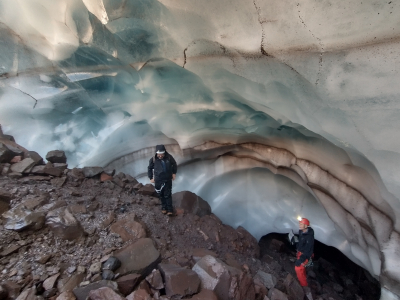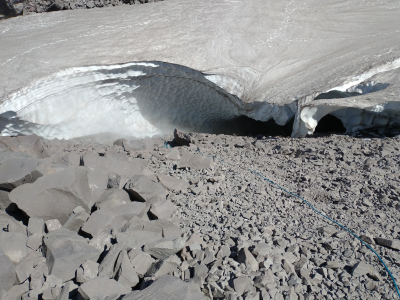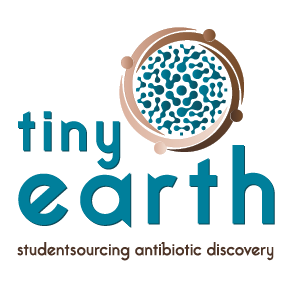
Photo from Dr. Anitori’s expedition to Mt. St. Helens
Every summer, Dr. Roberto Anitori, a Tiny Earth Partner Instructor (TEPI) at Clark College, visits Mt. St. Helens in Washington State to pursue hardy microorganisms called extremophiles, which live in extreme environments. Mt. St. Helens is abundant in extremophiles due to its unique circumstances: when the volcano erupted in 1980, a sterile crater was formed, which led to the formation of a glacier and numerous caves years later. Dr. Anitori’s research focuses on how these microorganisms survive in difficult environments, such as glaciovolcanic caves, and their potential role in antibiotic discovery.
An interest in astronomy led Dr. Anitori to study extremophiles. After realizing careers in astronomy were limited in Australia, he received both his Bachelor’s and Doctoral Degrees in Molecular Biology and Microbiology at the University of New South Wales in Sydney, Australia. Dr. Anitori first heard about astrobiology, the study of life beyond Earth, in 2000. The concept of microorganisms living in extreme environments on Earth set forth the idea that they could also live on planets like Mars and Jupiter, leading to the development of Dr. Anitori’s current research goals.
Dr. Anitori started exploring Mt. St. Helens in the summer of 2017 when he joined the Glacier Cave Explorers. This group includes experienced cavers and mountaineers who conduct interdisciplinary research and exploratory studies on caves in the Cascade Mountains, including Mt. Hood, Mt. Rainier, and Mt. St. Helens. Some caves they explore include Sandy Glacier caves, Summit Fumarole caves, and the Crater Glacier caves on Mt. St. Helens. These caves serve as the perfect environment for extremophiles because they do not receive natural light and are at a higher temperature due to volcanic fumarolic emissions. Without light, photosynthesis does not occur, so microbes either extract nutrients and energy from rocks or utilize volcanic gasses to survive.
Dr. Anitori’s research has two goals: (1) to find out what types of microorganisms live there and learn more about the microbial ecology of these environments, and (2) to find novel antimicrobials. Bacteria beneath the ice in Mt. St. Helens could be crucial to discovering new antibiotics in a world with increasing numbers of antibiotic-resistant bacteria. Tapping into glaciovolcanic caves and its reservoir of extremophiles expands the pool of undetected microbes with antibiotic activity. These organisms, exposed to the most limiting conditions that life can withstand, might have the solution to the decades-old antibiotic resistance crisis.
“…We’re expanding the pool of possible microbes by going to different extreme environments, which logically increases the probability that we will find a new antibiotic that hasn’t been seen before.” —Dr. Roberto Anitori
Dr. Anitori has been a Professor of Microbiology at Clark College in Vancouver, Washington since 2008. Students in Dr. Anitori’s classes are encouraged to explore their interest in microbes and antibiotic discovery by completing a project in which they analyze samples from his expeditions. He teaches a biology-focused Tiny Earth Course-based Undergraduate Research Experience (CURE), where students search for microorganisms that exhibit antimicrobial activity. Relevant samples are frozen and passed onto students in the second course for further research. In this genomics-focused CURE, developed by Dr. Anitori, students first obtain the complete genome sequence of the promising bacteria samples with nanopore sequencing, then look for Biosynthetic Gene Clusters using antiSMASH. Through these two courses, students have successfully discovered and identified microbes with antibiotic properties.

Photo from Dr. Antiori’s expedition to Mt. St. Helens
As a TEPI, Dr. Anitori first began teaching Tiny Earth in 2016 and returned to Tiny Earth Headquarters at UW-Madison in 2022 to complete the formal training. When asked about the difference between a CURE and a traditional science lab, Dr. Anitori says that while traditional science labs give students valuable training in terms of the use of equipment and scientific reasoning, CUREs take experimental design, data collection, and analysis a few steps further. Including samples from actual extreme environments provides a real-life depth to the research, and this realism includes both the positive and negative aspects of research. Through the development of their own project and the trials and errors that come with it, students are able to alter their expectations and experiments when faced with unsatisfactory results. Dr. Anitori mentions that teaching Tiny Earth has encouraged his interest in astrobiology to grow, which has subsequently helped bring his love for astronomy back into his research. Through the progression of his own research and interests, he helps students gain independence and self-efficacy while teaching them research skills that they may not have learned otherwise.
“A majority of my students who take the class are majoring in something else [not biology]… it’s really cool to see the students get a feel for what it’s really like to do research.” —Dr. Roberto Anitori
—Melis Baskaya (Tiny Earth Undergraduate Communications and Media Intern)

